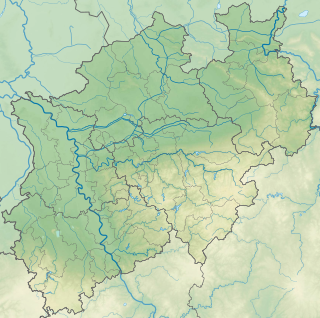Scheiderhöhe (natural area)
| Scheiderhöhe | |||
|---|---|---|---|
| Systematics according to | Handbook of the natural spatial structure of Germany | ||
| Greater region 1st order | Low mountain range threshold | ||
| Greater region 2nd order | Rhenish Slate Mountains | ||
| Main unit group | 33 → Süderbergland |
||
| About main unit | 338 → Bergische plateaus |
||
| 4th order region (main unit) |
338.6 → Wahlscheid-Seelscheid loess area |
||
| Natural space |
338.60 → Scheiderhohe |
||
| Geographical location | |||
| Coordinates | 50 ° 52 '23 " N , 7 ° 12' 59" E | ||
|
|||
| local community | Rösrath , Lohmar | ||
| state | North Rhine-Westphalia | ||
| Country | Germany | ||
The Scheiderhohe is, according to the Handbook of the Natural Region Divisions of Germany , a small-scale natural spatial unit with the number 338.60 and is one of the superior natural environment 338.6 ( Wahlscheid-Seelscheider Lößgebiet ). It comprises the area between the Agger and its tributary Sülz east of the Rösrath town center without the river valleys themselves. The southernmost point is at the level of the confluence of the Sülz in the Agger, in the north the route of the Aggertalbahn delimits the natural area. The largest settlements in the natural area are the Rösrath district of Lüghausen , as well as the Lohmar districts of Honrath , Scheid and the Scheiderhöhe of the same name .
The Scheiderhöhe borders in the north on the Sülz plateau ( order number 338.41) and in the east on the Wahlscheider Aggertal (338.61) within the Bergische plateau (338). In the west, the Untersülztal (550.02) joins the Bergische Heideterrasse (550).
The natural area is a 200 m high area which is part of the pleated hull base in the Rhenish Slate Mountains and has a loess cover . Numerous stream valleys with small side valleys, locally called Siefen , subdivide the area in small parts into Riedeln . The individual plateaus are covered by alkaline parabroot and are used as open agricultural land. There are numerous individual farms or hamlet-like settlements. The valley cuts are often wooded and end on plateau remnants, so-called dents , which are largely anthropogenically shaped.
